
Founder of GoodBed, Leading Mattress Expert
Read our take on the Nest Starling from Nest Bedding.
If you’d prefer to watch rather than read, check out our full Nest Starling video review above.
Table of Contents
Nobody does more in-depth mattress reviews than GoodBed — which means there's a lot of information here! Use the links in this table of contents to quickly jump to the sections of this review that interest you most.
| Summary | Overview of GoodBed's findings and conclusions about this product |
| Materials & Construction | Mattress Type, Layers, Cover |
| Comfort & Feel Ratings | Softness, Cushioning Depth, Memory Feel, Bounce |
| Back Support + Pressure Relief Ratings | By sleeper weight and sleep position |
| Feature Ratings | Motion Isolation, Temperature, Edge Support, Ease of Repositioning, Natural vs Chemicals, Adjustable Base Compatibility |
| Price, Value & Longevity | Cost, Discounts, Durability, Overall Value |
| Other Factors to Consider | Delivery, Returns, Warranty |
| Bottom Line | Who is the best/worst match for this mattress? |
Summary: Is the Nest Starling a Good Mattress?
The Nest Starling is an innovative new mattress that combines an all-foam design with customizable comfort materials and a unique “contour grid’ transition layer. This means that while the Starling feels like an all-foam or memory foam mattress, it can actually contour and align with your body in a manner that’s analogous to a pocket spring design.
The secret is in the contour grid just under the comfort layers. This is a layer of high-density foam that’s cut into a gridlike pattern that allows for segments of foam to function independently of other segments. This creates more conformance than what you would typically see from a flat sheet of poly foam.The contour grid is also cut slightly differently in different areas of the mattress to create zoned regions that are firmer or softer to adapt to a person’s curves.
In addition, the Nest Starling has a customizable comfort layer with two foams that can be flipped and reversed to modify the feel of the mattress. The first is a layer of Energex. This is an ultra high-density poly foam with a rapid response and a lively overall feel. The second is a layer of titanium and graphite-infused memory foam with a slow response and a softer feel.
We tested the Starling in both configurations and found both to be about a Medium-Firm on our scale. When handling these foam layers in isolation, we found that the Energex felt slightly firmer than the memory foam. However, when the memory foam was positioned as the top layer in the mattress, the slow response and feeling of "surface tension" created a sense of firmness. In our opinion, having the memory foam as the top layer felt slightly firmer, though again, we found both configurations to be about a Medium-Firm overall.
We also found that the Nest Starling had excellent motion isolation. We attribute this to the high-quality and conforming foams in the comfort layer and the motion isolating effect of the contour grid itself. It also performed well on an adjustable base, although the quite firm base foam prevented it from fully articulating with the base at a maximum incline. Still, it is compatible with an adjustable base and we do expect this to improve with time and mattress break-in.
In summary, the Nest Starling is a unique and innovative mattress. The use of a contour-cut transition foam is uncommon in the US mattress industry, and this creates more conformance and alignment than what we typically see with other all-foam designs. What’s more, the customizable comfort layers allow you to further fine-tune the mattress to your preferences. We think it’s a great option for people that like foam mattresses or for anyone that prioritizes pressure relief and motion isolation.
Bottom Line: Who is the Best Match for the Nest Starling?
BEST if you:
- Are looking for a foam or memory foam mattress
- Prefer a mattress with good conformance
- Want something that's customizable
- Are a side or back sleeper
NOT IDEAL if you:
- Are mostly a stomach sleeper
- Want a pure memory foam mattress
- Prefer a pocket spring or hybrid mattress
Comfort & Feel
These are the "preference-based characteristics" of a mattress. No classification here is better or worse – they are strictly a matter of your personal preference.
| Softness Level (1=Least Soft, 9=Most Soft) |
4 | Medium-Firm |
| Cushioning Depth (1=Shallowest, 9=Deepest) |
6 | Slightly Deep |
| Memory Feel (1=Least, 9=Most) |
6 | Medium-High |
| Bounce (1=Least, 9=Most) |
2 | Very Low |
Back Support (by Sleeper Type)
No mattress will provide equally good spinal alignment (a.k.a., back support) for every sleeper. Here's what to expect in terms of spinal alignment on this mattress – by sleeper weight and sleep position.
| Weight | Range | Back Sleepers | Side Sleepers | Stomach Sleepers |
| Lighter | <150 lb | 9 | 7 | 7 |
| Average | 150 to 200 lb | 9 | 8 | 6 |
| Above Average | 200 to 250 lb | 8 | 8 | 6 |
| Heavier | >250 lb | 8 | 8 | 5 |
Pressure Relief (by Sleeper Type)
The pressure relief offered by a mattress – especially important for side sleepers – will vary based on a sleeper's weight and body shape. Here's how we size up the pressure relief capabilities of this mattress.
| Weight | Range | Typical Curves | Extra Curvy |
| Lighter | <150 lb | 8 | 8 |
| Average | 150 to 200 lb | 7 | 7 |
| Above Average | 200 to 250 lb | 7 | 7 |
| Heavier | >250 lb | 6 | 6 |
Other Features
These are the "priority-based characteristics" of a mattress. Ratings here indicate where this mattress has strengths or weaknesses – however the importance of these features will depend entirely on your personal priorities.
| Motion Isolation | 10 | Exceptional |
| Stays 'Cool' | 6 | Pretty Good |
| Edge Support | 7 | Good |
| Ease of Repositioning | 7 | Very Good |
| Green Features | 3 | Fair |
| Adjustable Base Compatibility | 8 | Very Good |
| Overall Value | 8 | Very Good |
Key Facts
|
Mattress Type Memory Foam |
Price |
|
Delivery Free Shipping |
Return Policy 365-Night Trial |
|
Warranty Limited Lifetime Warranty |
Country of Manufacture United States |
|
Thickness 12.5" |
Weight (Queen) 90lbs |
Materials & Construction
What's in the Nest Nest Starling Mattress?
The Nest Starling is an all-foam mattress comprising roughly five overall layers
- 2” UHD poly foam (3lb "Energex Temperature Responsive Foam")
- 1.25" HD memory foam (4lb "Slow Response Memory Foam")
- 2" HD poly foam (2lb "Contour Grid Support Foam")
- 5.5” base foam (1.5lb "Transitional Support Foam")
- 1.75" UHD base foam (3lb "Base Support Foam")
At the top of the mattress we have a 2” layer of Energex. This is what we would call an “ultra high-density” (or UHD) poly foam with a rapid response. Some people call this a "latex-like" foam, and while we don’t think it feels quite like latex, it's certainly faster responding and more resilient than simple poly foam. Just under that, there’s a 1.25” layer of HD memory foam. This is a slower responding memory foam with a dense feel and a graphite and titanium infusion to manage heat retention.
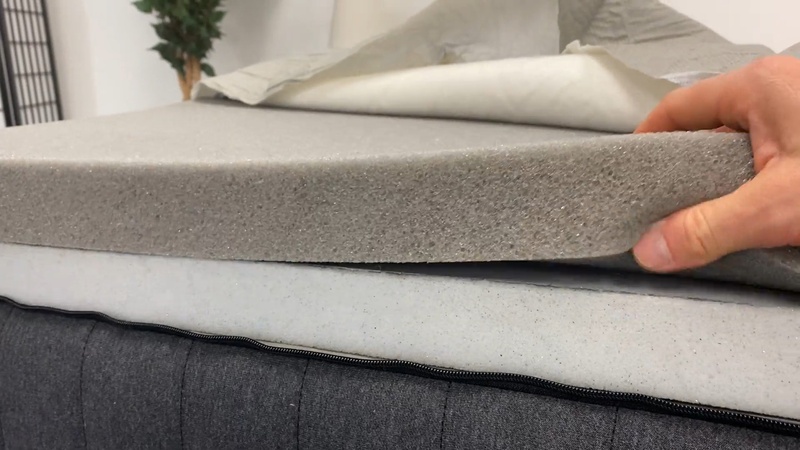
Underneath these initial comfort layers we have the "Contour Grid Support Foam." This is a layer of HD poly foam with channels cut into the surface to increase airflow and allow segments of the mattress to move relatively independently of one another. This layer is also zoned, with a contour cut pattern that’s slightly firmer in the middle third to support one’s hips and a pattern that’s slightly softer at one’s shoulders.
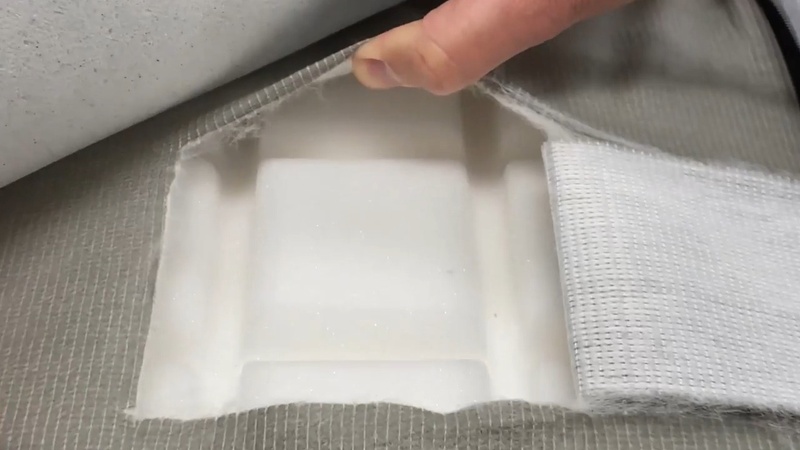
After this, we have about 5.5” of base foam (note - we say about here as this was actually 6” on our review model). Nest actually calls this a “Transitional Support Foam,” but we think it’s more of a support layer and not a transition layer. In other words, this is the layer that will be providing the bulk of support for the mattress. And underneath this there is a second layer of base foam that’s an even higher density.
Cover
The Nest Starling has an unzippable, stretch knit cover. Additionally, it also has some amount of phase-change material to help draw heat from a person’s body and create a cool sleep surface.

Comfort & Feel
There are three aspects that make up our assessment of comfort and feel. We call these "preference-based characteristics" because no rating here is better or worse – rather, the attributes that are most desirable to you will be determined solely by your personal preferences. We apply the same classification standards to each mattress so you can more easily compare apples to apples.
Softness ( what’s this )
Keep in mind that what mattress companies call “firm” or “soft” is relative and varies between manufacturers. Mattresses are designed to be supportive and promote healthy spinal alignment, however, different people tend to have different preferences for overall softness.
We found the Nest Starling to be about a Medium-Firm in feel. There are subtle differences between the two different configurations, but these were mostly felt in terms of initial surface characteristics, and not overall softness.
Not sure what softness is best for you? Take our Mattress Match Quiz and find out.
| Softness Level (1=Least Soft, 9=Most Soft) |
4 | Medium-Firm |
Cushioning Depth ( what’s this )
Cushioning depth refers to how deeply you sink into the mattress. Some brands will talk about a feeling of "sleeping-on" a mattress vs a feeling of "sleeping-in" a mattress, and this typically refers to cushioning depth. More cushioning depth means more conformance and more of a cradled or "hugged" sensation.
We thought the Nest Starling offered a slightly greater than average amount of Cushioning Depth. We attributed this to the contour grid foam just under the initial comfort layers.
| Cushioning Depth (1=Shallowest, 9=Deepest) |
6 | Slightly Deep |
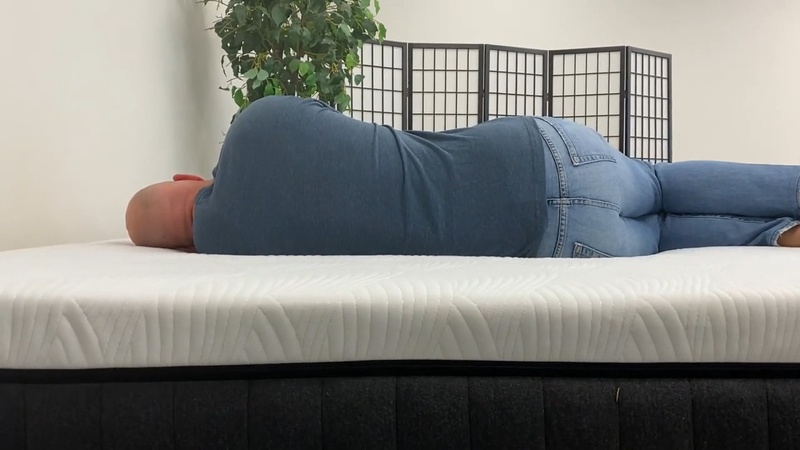
Memory Feel
Memory feel refers to how quickly a mattress recovers its shape after being compressed. A mattress with a lot of memory feel will have a much slower recovery after compression. This is often noticed by sleepers in repositioning.
We'd describe the Nest Starling as having a Medium-High amount of memory feel. This is particularly noticeable when the memory foam is on top of the mattress, but it's also noticeable even with the Energex on top.
| Memory Feel (1=Least, 9=Most) |
6 | Medium-High |
Bounce
Responsiveness also translates into bounce, and with most innerspring mattresses, you'll get a good bit of it.
The Nest Starling has almost no bounce whatsoever. There's the smallest amount of resilience felt in the Energex, but nothing deeper than that.
| Bounce (1=Least, 9=Most) |
2 | Very Low |
Back Support & Pressure Relief
The two things that you should always be sure to get from your mattress are spinal alignment (commonly thought of as "back support") and pressure relief. Unfortunately, no mattress will deliver these two things equally well for all sleepers. In particular, spinal alignment and pressure relief capabilities will vary across sleepers with different weights, body shapes, and sleep positions. To help you determine how this mattress will perform for you, we break down our spinal alignment and pressure relief assessments by sleeper type.
In our evaluations, the Nest Starling performed very well for our tester in most sleeping positions.
Spinal Alignment
The key to good back support is maintaining proper spinal alignment while you sleep. This means that the mattress should hold your spine in roughly the same position it's in when you're standing. The ability of a given mattress to do this will generally depend on your weight, sleep position, and body shape.
Here is how we break down the spinal alignment of the Nest Starling:
| Weight | Range | Back Sleepers | Side Sleepers | Stomach Sleepers |
| Lighter | <150 lb | 9 | 7 | 7 |
| Average | 150 to 200 lb | 9 | 8 | 6 |
| Above Average | 200 to 250 lb | 8 | 8 | 6 |
| Heavier | >250 lb | 8 | 8 | 5 |
Back Sleepers:
Our tester really enjoyed the Nest Starling in this position. The accommodating comfort layers and the contour grid provided the right amount of support.
Side Sleepers:
We also thought the Nest Starling was good for side sleeping. The zoned contour grid allowed for solid conformance and alignment.
Stomach Sleepers:
Our tester felt less well-supported on his stomach. However, a lighter individual may still do well in this position.
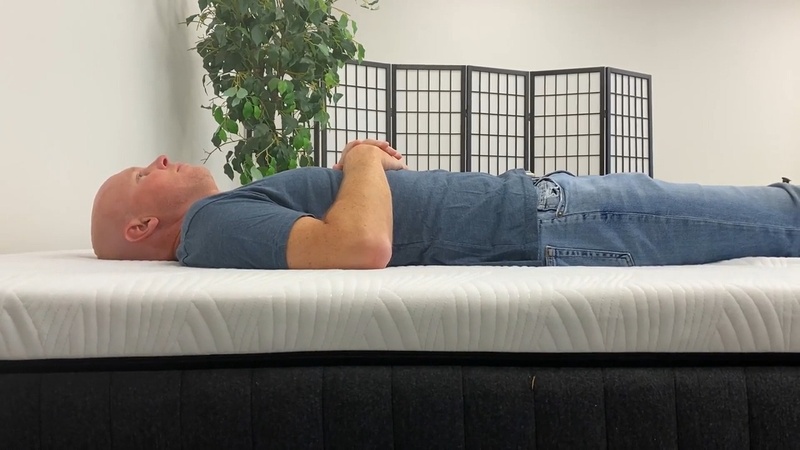
Pressure Relief
When a mattress pushes back against your body with too much force in a concentrated area, the result can be pain, soreness, loss of circulation, excessive tossing, and other problems. In general, such "pressure points" are of greatest concern for side sleepers, since that's the position in which your body's weight is distributed over the smallest surface area. To find the right mattress for your needs, keep in mind that the pressure-relieving capabilities of any given mattress will vary depending on the sleeper. Factors like your weight and body shape (e.g., broader shoulders and/or hips) will determine how far you sink into the mattress, and the pressure relief offered by that mattress will vary widely at different depths.
Here's how we sized up the pressure relief of the Nest Starling:
| Weight | Range | Typical Curves | Extra Curvy |
| Lighter | <150 lb | 8 | 8 |
| Average | 150 to 200 lb | 7 | 7 |
| Above Average | 200 to 250 lb | 7 | 7 |
| Heavier | >250 lb | 6 | 6 |
We thought that the Nest Starling had good overall pressure relief. The Energex and soft memory foam do a lot to prevent pressure.
Other Features
Beyond the preference-based characteristics of comfort and feel, and the body matching for spinal alignment and pressure relief, a mattress will have a number of other attributes that can make it a better or worse choice for you. We call these "priority-based characteristics" because they are areas in which a mattress can be better or worse, but that will have differing amounts of importance to each sleeper. So, determining how much importance to give to these features will be entirely a matter of your own personal priorities. As always, we apply the same ratings standards to each mattress so you can more easily compare apples to apples.
Motion Isolation ( what’s this )
If you are easily disturbed by a partner's movements in bed, or perhaps you and your partner go to bed and get up at different times, then motion isolation may be a priority for you. Generally speaking, pocket spring and all-foam mattresses tend to perform best here.
We thought the Nest Starling had exceptional overall motion isolation. It's rare that we see a 10/10 score here.
| Motion Isolation |
10/10 | Exceptional |
Temperature ( what’s this )
The Nest Starling also worked well in terms of temperature regulation. There's a small amount of phase-change material in the cover, and the memory foam has an added titanium and graphite infusion to help with heat mitigation.
| Stays "Cool" Rating |
6/10 | Pretty Good |
Edge Support ( what’s this )
The Nest Starling also did better than expected in terms of edge support. There's a firm 2" foam rail along the outside of the contour grid, and this greatly helped with overall edge support.
| Edge Support Rating |
7/10 | Good |
Ease of Repositioning ( what’s this )
If you tend to move and change positions a lot over the course of a night, ease of repositioning will be a priority for you. The Nest Starling also performed well in this area. Our tester had no trouble at all moving around or rolling into another position.
| Repositioning Rating |
7/10 | Good |
Green Features ( what’s this )
For mattress shoppers concerned with the use of natural materials, sustainable manufacturing practices or the like, we offer our subjective evaluation of any efforts taken by the company to make the mattress more green, healthy, or safe.
The Nest Starling doesn't really have any green features to speak of, although all the foams are CertiPUR-US certified.
| Green Rating |
3/10 | Fair |
Adjustable Base Compatibility ( what’s this )
We look at three things when testing a mattress on an adjustable base.
First, will using an adjustable base harm the mattress? In the case of the Nest Starling, the answer is no. Like most foam matresses, the Starling works well with an adjustable base.
Next, we look at conformance. How closely did the bed hug the curves of the base as it is raised and lowered? The Nest Starling did a pretty good job in this aspect. There was a slight gap between the mattress and foundation on the opposite side of the mattress, but this is also normal for new mattresses. We'd expect this to improve with time.
Lastly we look at the cover and what happens when the bed is in an articulated position. We did notice some very minor wrinkling of the cover when the head of the bed was raised, though again, this is normal for many mattresses and isn't typically noticed by sleepers.
Overall, we would say that the performance on our adjustable base was very good.
| Adjustable Base Use Rating |
8 /10 | Very Good |
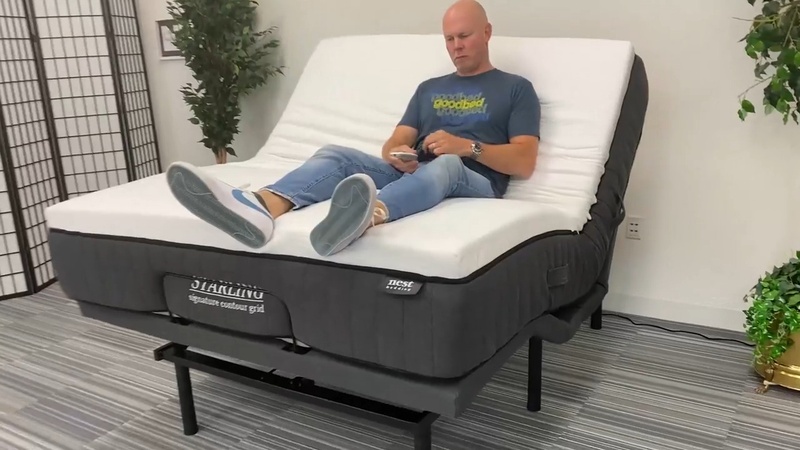
Price, Value & Longevity
How Much Does the Nest Starling Cost?
Prices shown are list prices. Remember that GoodBed keeps our site current with the best available discounts on online mattresses, many of which are exclusive discounts for our readers.
What Are You Getting?
The Nest Starling is an all-foam mattress with HD and UHD comfort layers and a unique contour grid to aid alignment.
How Long Will the Nest Starling Last?
When it comes to estimating the comfort lifespan of a mattress, we can use foam density as our best, albeit imperfect, predictor of how long a foam will retain its shape and resiliency.
We'd expect the Nest Starling to do well in this respect. All of the comfort layers are HD or UHD foams, which should last for many years. The only possible weak point would be in the 1.5lb base foam just under the contour grid, but this is balanced by the HD and UHD foams in every other layer. Additionally, the Starling is also backed by a lifetime guarantee from Nest Bedding.
Overall Value
We think that the Nest Starling compares well to most foam models on the market. The customizable comfort layers and the contour grid are also unique features that add a lot of value.
| Value Rating |
8/10 | Very Good |
Other Factors to Consider
Delivery
- Free delivery to your door
Returns
- 365-Night Trial period
- Lifetime Renewal Exchange
Nest offers a 365-Night Trial period. This is one of the longest trial periods in the industry.
Nest also provides a free Lifetime Renewal Exchange (LRE) with this mattress. The LRE is a one-time comfort guarantee that can be redeemed anytime during the lifetime of your mattress, whereby Nest will send you a new comfort layer to renew your mattress and save you the time and money it takes to shop for a new one.
Warranty
- Warranty Length: Limited Lifetime Warranty
- Indentation Coverage: 1” and above with some exclusions
One of the biggest, if not THE biggest complaints about any mattress from consumers regards body impressions — the inability of a mattress to spring back, eventually creating a low spot/sinkhole in the mattress. As such, mattress warranties all contain a term defining how big a sag or ‘body impression’ (measured when no one is on the mattress) is considered a defect, and thus covered under the warranty.
The industry standard for body impressions is 1.5" on most mattresses.
Nest has chosen to cover body impressions at or above 1" on the Nest Starling.
You read the fine print on this here: Nest's Warranty Policy.









































 Comparison
Comparison
 Related Video Reviews
Related Video Reviews



